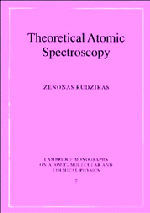Book contents
- Frontmatter
- Contents
- Preface
- Foreword to the Paperback Edition
- Introduction
- Part 1 Energy Spectrum of Many-electron Atom. Radiative and Autoionizing Transitions (Initial Formulas)
- Part 2 Foundations of the Angular Momentum Theory. Graphical Methods
- Part 3 Description of Complex Electronic Configurations
- Part 4 Second-quantization in the Theory of an Atom. Quasispin and Isospin
- Part 5 Matrix Elements of the Energy Operator
- Part 6 Electric and Magnetic Multipole Transitions
- Part 7 Calculation of Energy Spectra and Electronic Transitions in the Case of Complex Configurations
- 28 Methods of determination of radial orbitals
- 29 Correlation effects. Perturbation theory
- 30 The role of gauge dependence, relativistic and correlation effects in electronic transitions
- 31 Peculiarities of the structure and spectra of highly ionized atoms
- 32 Global methods in the theory of many-electron atoms
- 33 Peculiarities of configurations with vacancies in inner shells
- Epilogue
- References
- Index
33 - Peculiarities of configurations with vacancies in inner shells
Published online by Cambridge University Press: 21 September 2009
- Frontmatter
- Contents
- Preface
- Foreword to the Paperback Edition
- Introduction
- Part 1 Energy Spectrum of Many-electron Atom. Radiative and Autoionizing Transitions (Initial Formulas)
- Part 2 Foundations of the Angular Momentum Theory. Graphical Methods
- Part 3 Description of Complex Electronic Configurations
- Part 4 Second-quantization in the Theory of an Atom. Quasispin and Isospin
- Part 5 Matrix Elements of the Energy Operator
- Part 6 Electric and Magnetic Multipole Transitions
- Part 7 Calculation of Energy Spectra and Electronic Transitions in the Case of Complex Configurations
- 28 Methods of determination of radial orbitals
- 29 Correlation effects. Perturbation theory
- 30 The role of gauge dependence, relativistic and correlation effects in electronic transitions
- 31 Peculiarities of the structure and spectra of highly ionized atoms
- 32 Global methods in the theory of many-electron atoms
- 33 Peculiarities of configurations with vacancies in inner shells
- Epilogue
- References
- Index
Summary
Autoionization
Methods of theoretical studies of energy spectra and electron transitions, described in previous chapters, are also applicable to configurations with vacancies in inner shells. However, such types of configurations possess a number of peculiarities, mainly connected with problems of ensuring the orthogonality of the appropriate wave functions, with the changes of relative role played by relativistic and correlation effects. These peculiarities are manifest in the energy and radiation spectra of such systems. As a rule we shall only touch the main aspects of this problem. More detailed information may be found in the monograph by Karazija. From a physical point of view, processes involving inner electronic shells of free atoms and ions lead to X-ray and electronic (photoelectron and Auger) spectra. Appropriate theory may be used to interpret the spectra of gases and vapours as well as such spectra of solid state, containing atoms with open d- and f-shells and corresponding to transitions in inner shells. Comparison of such spectra of free atoms with the spectra of the same atoms in molecules or solid states allows one to elucidate the effects of free atoms and chemical surroundings, e.g. of the crystalline field.
The single-configuration approach remains the main method used, allowing one to describe not only qualitatively, but in many cases quantitatively, many features of various such spectra and the regularities in them. However, having in mind that relativistic effects grow very rapidly with increase of nuclear charge and with shrinking electronic shells, accounting for relativistic effects for this kind of phenomena is of paramount importance. Again, they may be taken into consideration as corrections in the Hartree–Fock–Pauli approximation or, starting with a relativistic approach, in the Dirac–Hartree–Fock approximation.
- Type
- Chapter
- Information
- Theoretical Atomic Spectroscopy , pp. 392 - 403Publisher: Cambridge University PressPrint publication year: 1997



